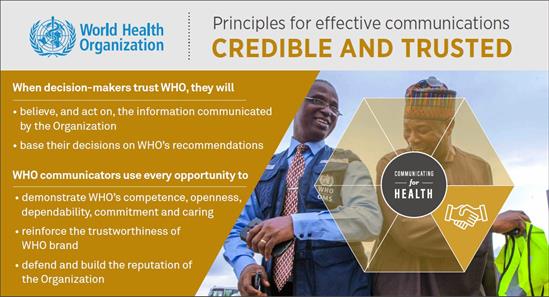
Principle: Credible and trusted
Be transparent
Tactics to apply to make your communications credible and trusted
Be transparent
To build trust, communicators must be transparent about how WHO analyses data and how it makes recommendations and policies. Messages also need to acknowledge uncertainty and quickly address any misconceptions or errors. Communicators must rapidly and publicly report the participants, processes and conclusions of:
- guideline development meetings
- International Humanitarian Relief (IHR) emergency committee meetings
- working groups.
Transparency of all communications is essential to ensure the credibility and trust of WHO information, advice and guidance.
Make information available quickly
For health threats of all kinds, it is important for WHO to provide the public and media with quick and easy access to up-to-date information.
For emerging health threats, communicators must inform people about the current state of knowledge in order to maintain confidence in WHO as a key source of credible information. If communication is delayed, stakeholders may conclude that WHO does not know what is occurring or is hiding information. They will turn to other sources for information. Communicators must work across headquarters, regional and country offices to quickly publish emergency, context-specific information. WHO’s Media Centre webpage provides a centralized source of information with links to:
- statements and notes for the media
- situation-specific webpages
- transcripts of press briefings
- online questions and answers
- fact files and fact sheets
- maps of affected regions.
Acknowledge uncertainty
Transparency is particularly important at times of high uncertainty. During public health emergencies, communicators may have to announce recommendations before all facts are known.
In these situations, communicators must ensure transparency and provide:
- interim public health recommendations, emphasizing that they could change as new information becomes available;
- preliminary research findings, such as recent vaccine trial results, letting audiences know about the limitations of the conclusions;
- clarification about what information is known and what is not known; and
- steps for how remaining questions will be answered.
Address errors
WHO communicates openly when the Organization has made an error and rapidly issues correct information. Communicators should determine which media channels and spokespeople can most effectively address the misinformation.
Communicate relationships with non-State actors
WHO collaborations require transparency and clear descriptions of the nature and purpose of relationships with other organizations.
WHO’s primary partners are its Member States and the health authorities in those countries. However, WHO also engages with non-State actors to encourage them to protect and promote public health. Coordinating messages with these organizations can raise the visibility of accurate health information and advice.
Non-State actors include nongovernmental organizations (NGOs), private sector entities, philanthropic foundations and academic institutions. Although often beneficial, these relationships can raise questions about potential conflicts of interest (a potential reputational risk), the Framework for Engagement with Non-State Actors (FENSA) has been created to provide ethical standards for work with private entities. Communicators are encouraged to use FENSA as an important resource for explaining how WHO works with partnerships in an ethical way, including:
- the principles of engagement
- risks and benefits
- types of interactions.







